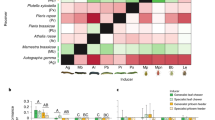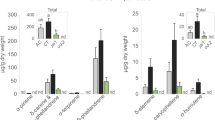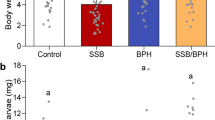Abstract
Plants are attacked by myriad herbivores, and many plants exhibit anti-herbivore defences. We tested the hypothesis that induced defences benefit tomato plants by encouraging insects to eat other members of their species. We found that defences that promote cannibalism benefit tomatoes in two ways: cannibalism directly reduces herbivore abundance, and cannibals eat significantly less plant material. This previously unknown means of defence may alter plant–herbivore dynamics, plant evolution and pathogen transmission.
This is a preview of subscription content, access via your institution
Access options
Access Nature and 54 other Nature Portfolio journals
Get Nature+, our best-value online-access subscription
$29.99 / 30 days
cancel any time
Subscribe to this journal
Receive 12 digital issues and online access to articles
$119.00 per year
only $9.92 per issue
Buy this article
- Purchase on Springer Link
- Instant access to full article PDF
Prices may be subject to local taxes which are calculated during checkout

Similar content being viewed by others
References
Karban, R. & Baldwin, I. T. Induced Responses to Herbivory (Univ. Chicago Press, 1997).
Karban, R., Yang, L. H. & Edwards, K. F. Ecol. Lett. 17, 44–52 (2014).
Karban, R. Plant Sensing and Communication (Univ. Chicago Press, 2015).
Orrock, J. L. et al. Trends Ecol. Evol. 30, 441–445 (2015).
Agrawal, A. A. & Klein, C. N. J. Anim. Ecol. 69, 525–535 (2000).
Poelman, E. H., van Loon, J. A. J. & Dicke, M. Trends Plant Sci. 13, 534–541 (2008).
Agrawal, A. A. Funct. Ecol. 25, 420–432 (2011).
Agrawal, A. A. Entomol. Exp. Applic. 115, 97–105 (2005).
Farmer, E. E. & Ryan, C. A. Proc. Natl Acad. Sci. USA 87, 7713–7716 (1990).
Tian, D., Peiffer, M., De Moraes, C. M. & Felton, G. W. Planta 239, 577–589 (2014).
Richardson, M. L., Mitchell, R. F., Reagel, P. F. & Hanks, L. M. Annu. Rev. Entomol. 55, 39–53 (2010).
Fox, L. Annu. Rev. Ecol. Syst. 6, 87–106 (1975).
Al-Zubaidi, F. S. & Capinera, J. L. Environ. Entomol. 12, 1687–1689 (1983).
Tian, D. et al. PLoS One 7, e36168 (2012).
Polis, G. A. Annu. Rev. Ecol. Syst 12, 225–251 (1981).
Andow, D. A. et al. Ecol. Entomol. 40, 229–236 (2005).
Karban, R., Agrawal, A. A., Thaler, J. S. & Adler, L. S. Trends Ecol. Evol. 14, 443–447 (1999).
Sadeh, A. & Rosenheim, J. A. Ecology 97, 1994–2002 (2016).
Thaler, J. S. Nature 399, 686–688 (1999).
Elvira, S., Williams, T. & Caballero, P. J. Econ. Ent. 103, 577–582 (2010).
Acknowledgements
Comments from E. Preisser and E. Damschen greatly improved the manuscript. We appreciate artwork by B. Feeny. J.O. was hosted by the Department of Biology at Virginia Commonwealth University (VCU) while writing the manuscript; VCU Biology, the Johnson, Vonesh and Damschen laboratories kindly shared space and equipment for conducting experiments.
Author information
Authors and Affiliations
Contributions
J.O. conceived the study; J.O. and B.C. designed the study; A.K., B.C. and J.O. conducted the experiments; J.O. performed all analyses and led manuscript preparation; B.C. and A.K. contributed to manuscript revision.
Corresponding author
Ethics declarations
Competing interests
The authors declare no competing financial interests.
Additional information
Publisher’s note: Springer Nature remains neutral with regard to jurisdictional claims in published maps and institutional affiliations.
Electronic supplementary material
Supplementary Materials
Supplementary Methods, Supplementary Results, Supplementary References, Supplementary Figures 1–5
Rights and permissions
About this article
Cite this article
Orrock, J., Connolly, B. & Kitchen, A. Induced defences in plants reduce herbivory by increasing cannibalism. Nat Ecol Evol 1, 1205–1207 (2017). https://doi.org/10.1038/s41559-017-0231-6
Received:
Accepted:
Published:
Issue Date:
DOI: https://doi.org/10.1038/s41559-017-0231-6
This article is cited by
-
The consequence of leaf life span to virus infection of herbivorous insects
Oecologia (2023)
-
Viral transmission and infection prevalence in a cannibalistic host–pathogen system
Oecologia (2023)
-
Understanding interdisciplinary perspectives of plant intelligence: Is it a matter of science, language, or subjectivity?
Journal of Ethnobiology and Ethnomedicine (2022)
-
Generalist herbivore response to volatile chemical induction varies along a gradient in soil salinization
Scientific Reports (2022)
-
Plant induced defenses that promote cannibalism reduce herbivory as effectively as highly pathogenic herbivore pathogens
Oecologia (2022)



